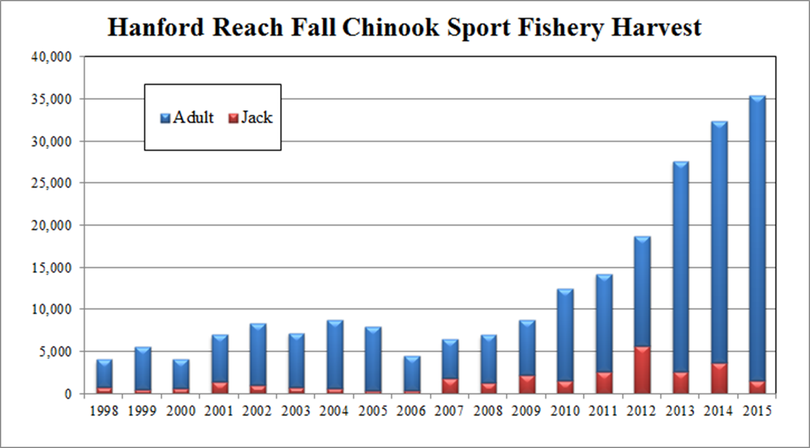Hanford chinook anglers have whopper season

FISHING -- Although the salmon run isn't over, the fall chinook fishery in the Hanford Reach closed on Oct. 31.
An estimated 35,432 fall Chinook were landed, a record harvest for this fishery, edging out the 2014 total of 32,427, says Paul Hoffarth, Washington Department of Fish and Wildlife biologist.
More than 48,000 angler trips were observed in the fishery in 2015, up from 44,098 angler trips in 2014.
Although the Columbia's chinook run has set several records this season and is close to being the best post-dams run since record-keeping started in 1938, it's not clear whether it will break the record for overall return to the mouth of the Columbia River set in 2013.
The 2015 run of fall chinook over Bonneville Dam stands at about 954,000 adult fish with a couple hundred salmon a day still coming in and heading upstream.
On the Snake River, chinook also are running with good news. Here's a report by Eric Barker of the Lewiston Tribune:
In 1990, only 78 fall chinook returned to the Snake River above Lower Granite Dam.
This year, fall chinook returning to the Snake River are poised to set a record – again.
Through Wednesday, 59,027 adult fall chinook had been counted passing Lower Granite Dam, about 35 miles west of Clarkston. That is slightly less than the 60,161 counted at the dam last year, an all-time high since the dam was completed in the 1970s. Fall chinook records have become almost commonplace in recent years, with high marks set in 2010, 2013 and again last year.
Becky Johnson, production manager for the Nez Perce Tribal Fisheries Division, said this year’s run could set a new record as fall chinook continue to trickle over the dam. The tribe fought to establish a hatchery program in the Snake River upstream of Lower Granite. The program’s aim is to produce fall chinook that return and spawn in the wild and eventually boost wild fish numbers. Combined with good ocean conditions and harvest restrictions, the program has led to an upward trend in fall chinook returns.
The majority of the fish returning this year and in recent years are from hatcheries. But Johnson estimates 30 percent to 50 percent of the fish in this fall’s run are natural origin fish. That means they were hatched in the gravel of the Clearwater, Snake, Grande Ronde and Imnaha rivers.
“They could have had hatchery parents, but they were born in gravel,” she said.
Natural origin fall chinook in the Snake River are protected as a threatened species under the Endangered Species Act.
Fall chinook also set return records for the Columbia River above Bonneville Dam and in the Hanford Reach near the Tri-Cities. Through Tuesday, 953,240 fall chinook, also known as upriver brights, had been counted at Bonneville Dam. The previous record at the dam was set in 2013 when 953,222 fall chinook were counted. An estimated 200,000 fall chinook are spawning in the Hanford Reach, a freeflowing section of the Columbia near the Tri-Cities.
“The success of this fall chinook run reflects the region’s commitment to healthy salmon runs and the collaborative spirit that has made it possible,” said Paul Lumley, executive director of the Columbia River Inter-Tribal Fish Commission “The tribes celebrate this year’s return and pledge to continue our protection and restoration work that helped make it possible. The lessons the region has learned in achieving the success we’ve seen so far will help us address upcoming impacts such as the predicted El Nino this winter and the long-term effects of climate change.”
The fall chinook fishing season ended Oct. 31 on most of the Snake River and short sections of the lower Clearwater and lower Salmon rivers. One remaining section of the Snake River, between Cliff Mountain Rapids and Hells Canyon Dam, will close Tuesday.
This fall, Idaho anglers harvested 594 adults and 170 jacks from the Snake River and 150 adults and 22 jacks from the Lower Clearwater River. But anglers caught and released many more fall chinook. On the Snake, anglers released 2,544 adults and 452 jacks. On the Clearwater, 421 adults and 47 jacks were released.
Fisheries managers in Idaho and Washington have been pushing federal officials at the National Marine Fisheries Service to allow states to fish for and harvest fall chinook in the Snake River that have not had their adipose fins clipped. Removal of the fins generally identifies the fish as being from hatcheries. But only about 50 percent of hatchery fall chinook released in the Snake River have been fin-clipped. Joe DuPont, regional fisheries manager at the Idaho Department of Fish and Game at Lewiston, said the department is resolved to push harder for the change this winter in hopes that it can be in place for next fall’s fishing season.
In one sour note, only 11,448 fall chinook jacks – fish that return after just one year in the ocean instead of two or more – were counted passing the dam this fall. That is the lowest number since 2008 and could be another signal that ocean conditions are turning poor. Waters off the West Coast of the U.S. and Canada have been warming and fisheries scientists say that could mean some lean years are coming for Snake and Columbia River salmon and steelhead.
This year’s coho run is likely an early sign of the less productive conditions in the ocean. Only 1,309 coho were counted at Lower Granite Dam, compared to an all-time high of nearly 18,000 last year. In the Columbia River, coho numbers dipped from a massive 275,560 counted last year at Bonneville Dam to only 35,661 this year.
